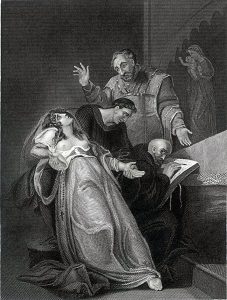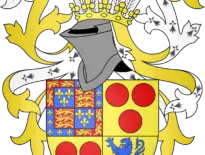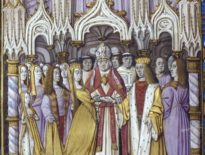 Little is known about the early life of Elizabeth Barton. We do not know anything about her childhood or her family; however, she probably received little to no formal education and was probably illiterate. She first enters the public eye aged 19, when she was working as a servant in the house of Thomas Cobb, the farm manager to Archbishop William Warham.
Little is known about the early life of Elizabeth Barton. We do not know anything about her childhood or her family; however, she probably received little to no formal education and was probably illiterate. She first enters the public eye aged 19, when she was working as a servant in the house of Thomas Cobb, the farm manager to Archbishop William Warham.
While working as a servant, Barton became severely ill, during which time she claimed to receive divine inspiration. This ‘illness’ prevented Elizabeth from eating and drinking, and during her sickness, she began prophesying. She predicted that a sickly child would die, spoke about the ten commandments and the seven deadly sins, and saw visions of heaven. Her visions and prophecies began to gain traction in the local community. Eventually, the parish priest Richard Master travelled to Canterbury to inform Archbishop Warham of her seemingly holy abilities. Warham investigated Barton’s skills, and when questioned, she was found to be of a strong and orthodox faith. Following her interrogation, it is said that she predicted God would cure her illness in the village of Court-at-Street. In 1526, it was reported that she travelled there and was cured, in front of three thousand spectators. Barton also professed that it was divine will that she become a nun and that a monk named Father Bocking, who conducted her investigation, should be her spiritual advisor.
Following the event at Court-at- Street, Elizabeth entered the Benedictine priory of St Sepulchre in Canterbury. By the summer of 1527, she had taken her vows to become a nun. Bocking was appointed as her confessor and advisor, and he sent accounts of her revelations to Henry VIII. Henry passed these documents to Thomas More, wanting his expertise on her visions. Thomas More responded to the document by saying:
“that in good faithe I founde nothinge in these wordes that I coulde eny thinge regarde or esteme, For savinge that some parte fell in rime, and that, God wotte, full rude, els for any reason, God wott, that I saw therin, a righte simple woman mighte, in my mynde, speake it of her owne witt well ynoughe’ (Correspondence, 481).’
During her time in the convent, Barton studied the lives and revelations of Bridget of Sweden and St Catherine of Siena, and it is clear from her later revelations and experiences that she modelled herself on those women. Barton’s reputation had spread by the time she had joined the convent, and as such, people would travel to gain her perspective on their lives, they would ask her to commune with spirits, and they implored her to beg for God’s intervention with sickly loved ones. Even Archbishop Warham visited her, and he found himself impressed, praising her to John Fisher, the Bishop of Rochester. Warham even wrote to Cardinal Wolsey commending her to him and indicating that she wanted to meet with the cardinal. Wolsey interviewed her at least twice, and it is believed that it was his insistence which gained her an audience with the king. Barton spoke to Henry VIII about numerous revelations, and it is believed she held royal favour for a time. However, this would soon turn sour.
Between the years 1526 and 1534, Elizabeth Barton’s predictions and prophecies became increasingly political and correlated with the religious and political turmoil of the time. When Henry VIII began to shift his religious policies, Barton became a fierce opponent, arguing that the estates and revenues of the Church and pope should be protected and that those who had heretical thoughts against the Catholic Church should be condemned. That Barton continued to spread inflammatory religious ideologies which directly contradicted the will of the king was dangerous enough; however, her downfall came when she involved herself in the ‘Great Matter.’ Barton was a staunch defender of Katherine of Aragon and was virulently opposed to Anne Boleyn. Barton took her opposition to the next level, however, with her most provocative prophecy when she stated that if Henry married Anne, then he would die:
“that in case hys Highnes proceded to thaccomplishment of the seid devorce and maried another, that then hys Majestie shulde not be kynge of this Realme by the space of one moneth after, And in the reputacion of God shuld not be kynge one day nor one houre.”
25 Henry VIII, c. 12, Statutes of the Realm, 446
Barton also issued threats to Archbishop Warham and Cardinal Wolsey that God would punish them should they continue to support the king in his quest for divorce. In October 1532, Barton predicted Henry’s excommunication from the Church in a ‘divinely inspired vision’, and by the end of 1532, Thomas More decided to speak with her, as he had become worried about her increasingly political predictions. Elizabeth Barton had considerable authority in religious circles, and she had friends at court including a staunch critic of the king, Gertrude Courtenay, Marchioness of Exeter. Katherine of Aragon refused to give her audience, but Barton communicated with Pope Clement VII through translators and ambassadors, commending him for his stance against Henry.
By 1533, Elizabeth Barton was in trouble. Archbishop Cranmer wrote to St Sepulchre’s requesting that Barton be brought to him at his manor at Otford. She was questioned but released, then Thomas Cromwell began his investigation. He questioned her and arrested Father Bocking, having the latter’s premises searched. Following a full investigation, Barton was arrested and placed in the Tower by November 1533. On 16th November, she confessed to being treasonous against the king, and a heretic. She was forced to do penance at St Paul’s Cross in London and was publically denounced and her crimes read out. By March 1534, Barton and Father Bocking were indicted of high treason by act of attainder. The act of attainder demanded that any books or writings by Barton be surrendered, with threats of fines and imprisonment. On 20th April 1534, Barton was executed; first, she was hanged, and then she was beheaded. Her head was then placed on a pike on London Bridge, and her body was buried in Greyfriars Church in Newgate Street.
Georgia has just finished her masters in Classics at the University of Edinburgh. Academically, Georgia is interested in early Christianity, with her master's thesis focusing on "The Male Gaze and Self-Representation in Female Christian Narratives". In addition to her interest in ancient history, she has always been an avid lover of the Tudor era, drawn to the magnificence of the Tudor courts and the larger than life characters. She is particularly interested in The Reformation, Christianity and the shifting sands of ecclesiastical politics in this period and also has a keen interest in the lives of Tudor women. It is Georgia's ambition to become a writer, perhaps publishing her own Tudor novel one day.
Georgia also runs a history blog and instagram page called Historia Mundis.
Bibliography
- A Luders and others, eds., Statutes of the realm, 11 vols. in 12, RC (1810–28), vol. 3, pp. 446–51.
- The correspondence of Sir Thomas More, ed. E. F. Rogers (1947).
- E. J. Devereux, ‘Elizabeth Barton and Tudor censorship’, Bulletin of the John Rylands University Library, 49 (1966–7), 91–106.
- R. Rex, ‘The execution of the Holy Maid of Kent’, Historical Research, 64 (1991), 216–20.
- S. L. Jansen, ‘Elizabeth Barton: “the Holy Maid of Kent”’, Dangerous talk and strange behavior: women and popular resistance to the reforms of Henry VIII (1996), 41–56.
- A. Neame, The Holy Maid of Kent (1971).
- D. Watt. Barton, Elizabeth, the Holy Maid of Kent. Oxford Dictionary of National Biography (2004).



Thank you for this article I found it very interesting and informative
What a great summary of an inspiring life that came to a tragic end..
Thank you. I’d never heard of her.